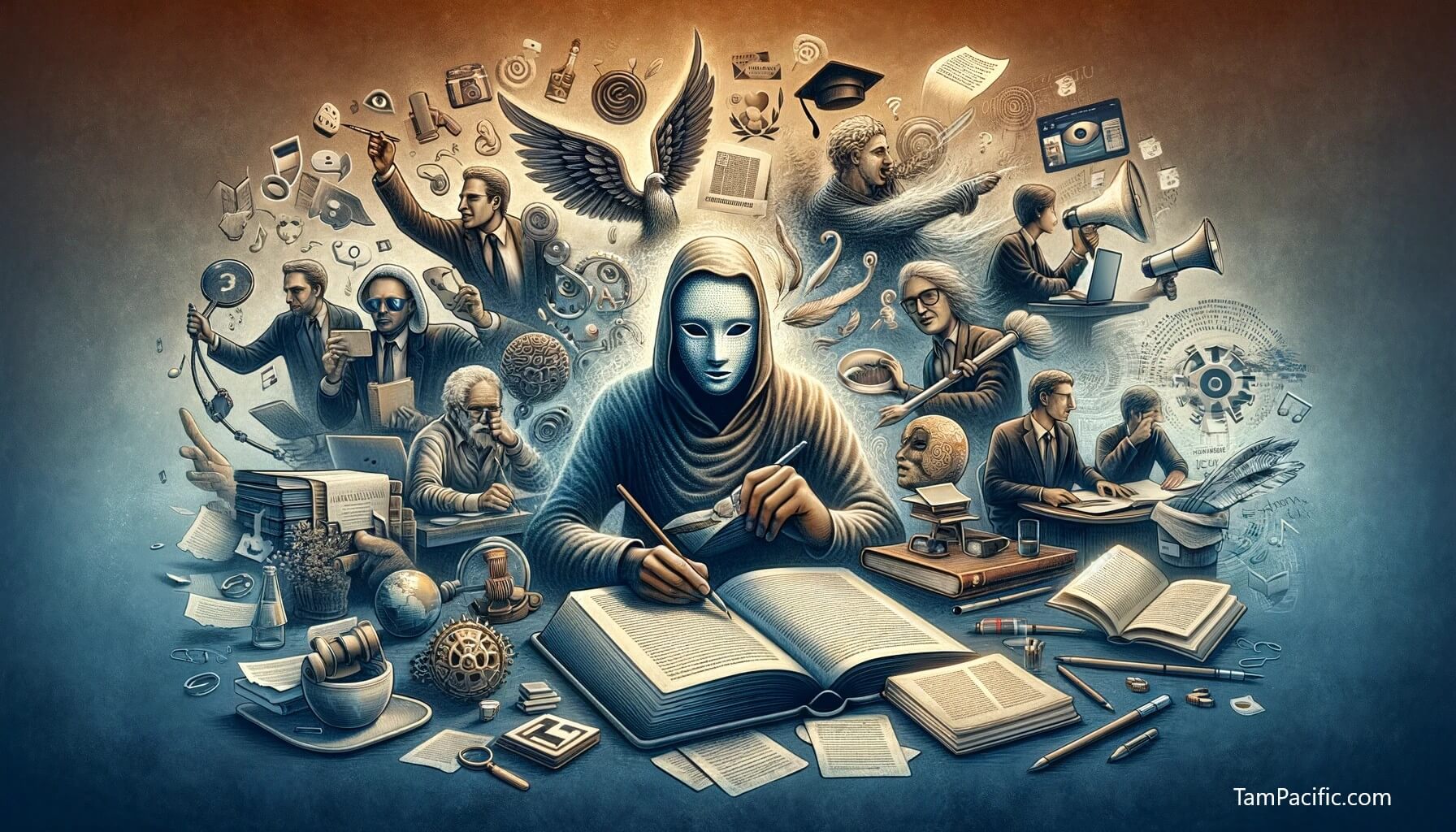
“Author” refers to an individual who writes and creates original content, typically in the form of books, articles, essays, poems, or other written works.
Authors can produce content in various genres and fields, including fiction, non-fiction, academic, journalistic, and creative writing. The term “author” can also apply to the creator of a work in other media, like a playwright for theater or a screenwriter for film and television, but it’s most commonly associated with written texts. The role of an author is not just to write, but also to express ideas, tell stories, convey information, and engage with readers through their written word.
The concept of an “author” can be understood and dissected in various ways, leading to multiple perspectives and interpretations. Here are some key concepts related to authors:
1. Traditional Author: Traditionally, an author is someone who writes books, articles, or other texts. This is the most common and straightforward understanding of an author.
2. Legal Authorship: Legally, an author is often defined as the originator of a work and holds copyrights to it. This concept is crucial in discussions of intellectual property.
3. Literary Theory Perspectives: In literary theory, particularly postmodernism, the role of the author is critically examined. Roland Barthes, for example, argued in his essay “The Death of the Author” that the author’s intentions and biography should not constrain interpretation of a text.
4. Collaborative Authorship: This concept recognizes that some works are created collaboratively. This can include co-authors of a book or participants in collaborative projects like wikis or open-source software.
5. Ghostwriting: In this concept, an individual writes a text that is officially credited to another person. This challenges traditional notions of authorship.
6. Author as a Brand: Especially in commercial literature, an author can be seen as a brand, with their name serving as a selling point and guarantee of a certain style or quality of writing.
7. Digital and Multimedia Authorship: With the rise of digital media, the concept of authorship has expanded to include creators of digital content, such as bloggers, video producers, and social media influencers.
8. Anonymous or Pseudonymous Authorship: Some authors write under pseudonyms or anonymously, which raises questions about identity and authorship.
9. Authorial Intent vs. Reader Response: This concept explores the tension between what an author intends to convey and how readers interpret the work.
10. Cultural and Historical Context: The role and recognition of authors can vary significantly across different cultures and historical periods.
Each of these concepts offers a different lens through which to understand what an author is and what constitutes authorship.
Thank you to the authors at TamPacific.com for your insightful and informative articles, your contributions greatly enrich the understanding and appreciation of your readers.
- ✍️ Adem Guleryuz
- ✍️ Alessia Santoro
- ✍️ Anh Tram San
- ✍️ Cemile Solak
- ✍️ Dang Nguyen Anh
- ✍️ Daniel Peterson
- ✍️ Dinh Duc Hoi
- ✍️ Doan Van Dieu
- ✍️ Emin OZTURK
- ✍️ Ha Minh Tuan
- ✍️ Ha Trieu Huy
- ✍️ Hoang Thi Hue
- ✍️ Hoang Mai Trang
- ✍️ Huynh Thi Hau
- ✍️ Jihan Hassan Mohammed Ali
- ✍️ Le Thuy Linh
- ✍️ Maha Ahmed Mohamed
- ✍️ Marcus Hynes
- ✍️ Melike Peterson
- ✍️ Michelle Greenberg
- ✍️ Nabendu Pal
- ✍️ Neveen Samir Mohamed
- ✍️ Nguyen Hoai Thu
- ✍️ Nguyen Hong Huan
- ✍️ Nguyen Huong Hoai
- ✍️ Nguyen Minh Giang
- ✍️ Nguyen Nhan Hoai
- ✍️ Nguyen Thanh Luan
- ✍️ Nguyen Thi Kim Anh
- ✍️ Nguyen Tuan Dung
- ✍️ Nguyen Tuan Kiet
- ✍️ Nguyen Van Phuoc
- ✍️ Nutrition Facts
- ✍️ Pham Thanh Hung
- ✍️ Pham Thi Lan Huong
- ✍️ Pham Van Hien
- ✍️ Robert Preston Williams
- ✍️ Serdar KUM
- ✍️ Takashi Fukue
- ✍️ Tam Pacific
- ✍️ Tran Cao Bao
- ✍️ Tran Tan Van
- ✍️ Tran Thi Tuyet
- ✍️ Tran Tuan Nam
- ✍️ Trieu Thanh Quang
- ✍️ Trinh Thi Phuong Ly
- ✍️ Victor Langley
The term “category” has multiple meanings, depending on the context:
1. General Definition: In a broad sense, a category is a class or group of things or people that share some common characteristics or qualities. It’s a way of classifying or grouping similar items.
2. Mathematics: In mathematics, particularly in category theory, a category is a collection of objects and arrows (also called morphisms) between these objects. It’s a formal structure that allows mathematicians to study and define mathematical concepts in a very general and abstract way.
3. Philosophy: In philosophy, especially Aristotelian and Kantian philosophy, categories are basic types or kinds of things. They represent fundamental concepts through which we understand the world.
4. Library and Information Science: In libraries and databases, a category refers to a group of items that are classified together based on common attributes, like genre, subject, or format.
5. Retail and Business: In retail and business contexts, categories refer to groups of products or services that are similar or related, like “beverages” or “electronics”.
6. Computing and Data Organization: In computing, categories can refer to ways of classifying and organizing data, software, or other elements within a system.
Thank you!
Website Management Board
https://tampacific.com
You are viewing the article:
Author for TamPacific.com
Link https://tampacific.com/author
Hashtag: #Authorship #WritingCommunity #LiteraryTheory #CopyrightLaw #CollaborativeWriting #Ghostwriting #AuthorBrand #DigitalAuthorship #PseudonymousWriters #ReaderResponseTheory #CulturalContext #HistoricalPerspective #CreativeWriting #PublishingIndustry #IntellectualProperty
Keywords: Authorship Concepts; Traditional and Digital Authors; Literary Theory and Interpretation; Copyright and Legal Authorship; Collaborative and Co-Authorship; Ghostwriting Services; Author Branding Strategies; Multimedia Content Creation; Anonymous and Pseudonymous Writing; Reader Response in Literature; Cultural Influences on Writing; Historical Context of Authorship; Creative Writing Techniques; Publishing Trends and Insights; Intellectual Property in Writing.
